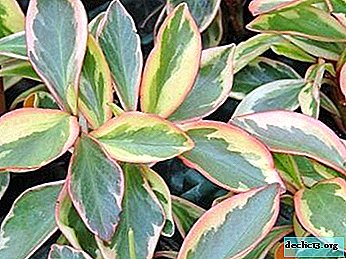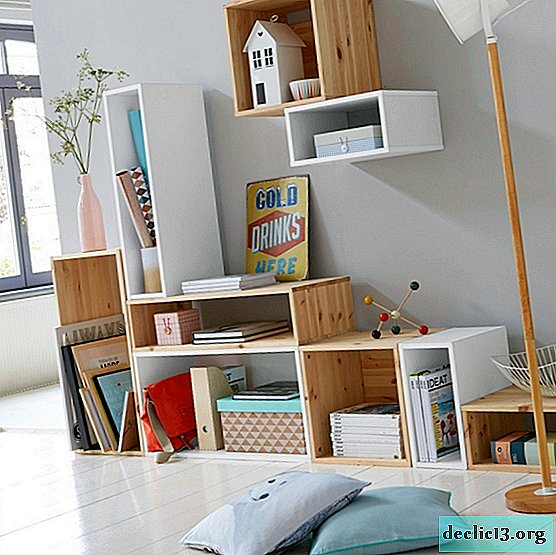Practical recommendations for the cultivation of peperomia clubusulosa. Features of care and flower photo

Numerous types of peperomies have attracted the attention of lovers of indoor floriculture for decades. Among them, there are many different varieties, both in leaf color and in shape: bushy, erect, and ampelous.
One of the popular varieties is the clusieliform peperomia. It is distinguished by bewitching decorativeness due to the unusual color of the leaves.
About the features of cultivation and the basic rules for caring for this peperomy will be discussed in this article.
Botanical description and photo
Peperomia clusiifolia belongs to the family of peppers, the genus Peperomia. This is a large perennial herb with dense stems up to 40 cm long, ascending and rooting in the lower nodes.
The leaves are alternate, obovate in shape with a blunt or notched tip, slightly elongated at the base, large up to 15 cm, with short petioles, dark green with a reddish tint and a narrow dark purple border around the edge, elastic and matte. Small flowers are collected in elongated inflorescences of small sizes.
Reference. The description of this genus is first encountered in the three-volume work Peruvian and Chilean Flora, published in Madrid in 1794 after an expedition to the South American continent. The authors of the fundamental study were the Spanish botanists Hipolito Ruiz Lopez and Jose Pavon y Jimenez.The wetland tropical forests of Venezuela and the Antilles are called the homeland of Peperomia kluzielistnaya, where this perennial grows on a mossy cushion of rocky ledges and on rotting trunks of old trees.
Photo peperomia kluzielistnoy presented below.



Home Care
- Temperature. Peperomia is a thermophilic plant and prefers room temperature. In winter, she needs a cool room. This species is especially intolerant of drafts, so keep the flower away from window leaves and doors. The pet is especially sensitive to soil temperature.
The difference between the temperature of the air in the room and in the pot with soil should not exceed 1-2 degrees.
- Watering. Water is maintained for irrigation for at least 3 days. In summer, the tropical guest is regularly watered with soft, warm water. Between watering, a period of time is required to dry the lump of soil.
The water accumulated in the pan after watering must be drained. In the autumn-winter period, flowers are watered less, carefully observing that the soil remains warm. You should be wary of cold water - delicate roots are easy to get cold.
- Shine. To preserve the decorative properties of the peperomia kluzielistnaya, you will need to contain it in bright but diffused lighting.
Important! Avoid direct burning sun rays from 12 to 16 hours in the spring and summer.
- Priming. The weak root system of peperomia develops in a small volume of soil, so the soil should be especially nutritious and balanced in composition. For the development of the plant, a loose, slightly acidic substrate is required. The best mixture for planting is turf, peat and sand in a ratio of 2: 2: 1.
- Pruning. To achieve spherical bushiness, it is necessary to pinch the shoot for one fifth of the length. If the plant is grown in an ampelous manner, long shoots along the edges of the pot do not touch, and in the center the stems are cut by a third.
- Top dressing. Peperomia is fed during active growth from March to August once every 2 weeks with liquid complex fertilizer for indoor plants containing nitrogen, phosphorus and potassium. It is useful to alternate top dressing with organic and mineral fertilizers. The dose of fertilizer is taken in half as much as in the instructions!
- Pot. When choosing the size of the pot, it is taken into account that the roots of peperomia love crowding, therefore, when transplanting, they leave the plant in the same pot or increase its capacity by only 10%.
For transshipment, either wide plates or containers of standard proportions should be used. Drainage holes and a layer of 5-6 centimeters covered with coal or expanded clay should be present in the landing tank to prevent the danger of decay of tender roots.
 Transfer. Regular transplantation is recommended every two to three years. To do this, you need:
Transfer. Regular transplantation is recommended every two to three years. To do this, you need:- fill a third of the volume of the new pot with drainage;
- pour a layer of soil mixture and moisten it;
- carefully remove peperomia along with a lump of earth from the old tank;
- lower the plant into a new pot and carefully fill up the substrate without ramming it;
- to shrink the earth, the flower needs to be well watered, and then the rest of the soil should be added;
- water from the pan must be drained.
- Wintering. When keeping the plant in a city apartment, it is difficult to lower the wintering temperature to 16 degrees. Therefore, lovers leave the tropical beauty to winter in normal room conditions, providing good lighting and refraining from feeding. The most important thing in leaving during this period is to prevent drafts and drying out of the coma of the earth.
Breeding
There are several ways to breed peperomia kluzielistnaya:
- Apical, stem and leafy cuttings (at a soil temperature of 20-25, cuttings easily root at any time of the year, both in wet sand and in water, and after 3-4 weeks young plants can be transplanted into separate plates).
- Dividing the bush (you need to carefully divide the root system of an adult plant so as not to damage the roots, and the divided bush is planted in smaller pots).
- Less commonly propagated by seeds (Sowing is carried out in flat containers filled with a mixture of sand and soil in equal proportions. After sowing, they are covered with glass and germinated at a temperature above 24 degrees, periodically moistening the soil until the first pair of leaves appears. Seeds germinate quickly, within 2 weeks. Seedlings dive into a common box at a distance of a couple of centimeters from each other and put in a well-lit room).
Bloom
Peperomia blooms most often in spring or summer, form long spike-shaped inflorescences resembling flower-bearing shoots of plantain. Flowers are formed only in conditions of short daylight hours (less than 12 hours).
Attention! To preserve the lush crown of a perennial, flower stalks are recommended to be removed at the stage of formation, so that the plant does not waste energy on flowering.If you leave the flowers, then after flowering the bush becomes less dense, begins to drop leaves and lose part of the stems. In room culture, peperomy seeds do not ripen.
Diseases and Pests
 Of the pests for peperomia, the danger is:
Of the pests for peperomia, the danger is:
- mealybug;
- red spider mite;
- thrips and others.
Because of these insects, such plants drop leaves and can die. From the worm, the alcohol processing of the leaves helps. Of the diseases of peperomia, root rot, discoloration of leaves, scab, and others are noted.
Similar flowers
Great neighbors for peperomia are ivy, dracaena, philodendrons and headers. It looks great in mixed plantings with plants that require the same conditions.
Peperomia kluzelistny - unpretentious and friendly houseplant, improves mood on cloudy autumn days, when there are not enough colors around, and looks great in any interior.

 Transfer. Regular transplantation is recommended every two to three years. To do this, you need:
Transfer. Regular transplantation is recommended every two to three years. To do this, you need:















